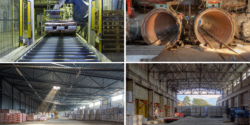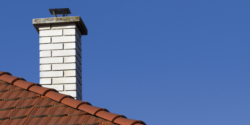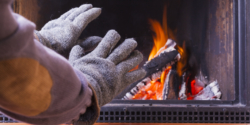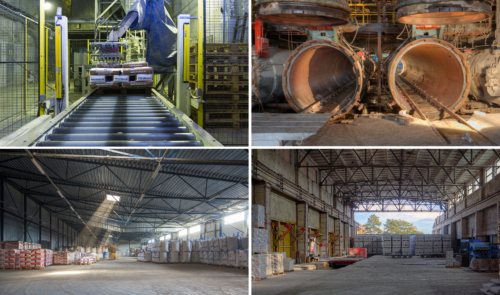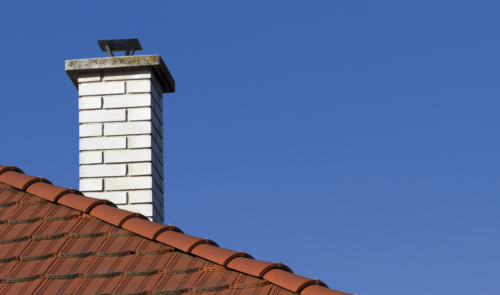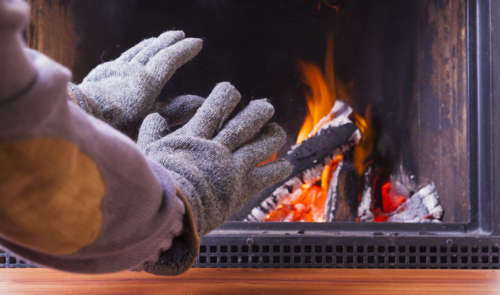There have been great progress in the construction materials industry in the past 10-20 years to develop new materials and technologies. As a result, the modern houses usually have better heat retention. Also stoking habits have changed – people stoke less often, depending on the weather even not every day. In addition, stoking skills and wisdom has been lost or has changed. Instead of dry wood, people use logs that are not dry enough in their new fireplaces. In the worst case, they think that they can burn anything that catches fire in their chimney. Also all heating devices have undergone a complete technological innovation – the goal being effectiveness. There are economic solid fuel boilers, pellet boilers, gas and oil boilers. The selection is wide and it is improving year by year.
Silicate stone is a weatherproof and very durable construction material. In Estonia, it is common to build the part of the chimney on top of the roof i.e. the chimney head from silicate bricks, as it is more durable to weather than burned clay bricks. As the chimney head is the part of the house that has to endure the most extreme climate and temperatures, the following guidelines are required to ensure the longevity of a chimney head:
- The chimney must be covered with a sheet metal or concrete cap, which would be 50mm wider than the chimney at all sides.
- A chimney’s ventilation is in direct relation with the constructional state of a brick chimney, wherefore the poor ventilation of a poorly built chimney causes flue gases to have lower temperatures, which in turn create more condense water. This is why a metal sleeve should be used when renovating a chimney’s flute (see section from the book Korstna ja küttekolde müürimine at the end of this manual). Ventilation of the chimney worsens when the building is airtight and by natural wear-and-tear of a chimney used for a long time. Façade renovations and changing windows/doors, if forced ventilation has not been designed for the building, cause ventilation to worsen in the smoke flute. For that, it is recommended to leave vents in the exterior wall that can be regulated to provide more oxygen to the building to improve burning.
- The chimney and fireplace must be designed and built so that the temperature at flue gas exits would not be below100˚C.
- When liquid fuel (oil, gas etc.) is used as the fuel in a boiler, the temperature of combustion gases will be below 100 ˚C. Due to the low flue gas temperature and large quantities of water in the flue gas, liquid begins to condensate in the chimney head area. The condensate (sulphuric acid solution SO₂ , SO₃) is corrosive and begins to actively break down the flue. This is why all liquid fuel boiler manufacturers recommend to use acid-resistant pipes (either stainless steel or ceramic) in the chimneys of liquid fuel boilers.
- When heating a building during the winter, the great differences in the temperatures within the chimney head create a situation where moisture is pushed from the interior of the flue towards colder surfaces – out. This process of drying out takes – in case if a 120 mm stone and joint -3-6 months. This increases the concentration of moisture in the chimney head. After that, the night-time frost cools down the chimney quite quickly after the fireplace was stoked and the moisture on the exterior of the chimney head and also in the stone and in joints crystallizes (ice crystals appear). The appearance of ice causes increase in volume, which in turn creates internal tensions. Due to the internal tensions, the silicate bricks begin to crack on top or split through the 120 mm stone. This is why in our climate it is recommended to build a chimney head by the beginning of September.
- Only dry wood with a moisture content of up to 20% should be used for stoking.
- Building a chimney has to be guided by the standard for fire safety of constructions EVS 812-3:2007 and the Fire Safety Act. The new Fire Safety Act entered into force as of 1 September 2010 and one of its main amendments affects homeowners. Pursuant to subsections 11(4) and 11(5), at residential buildings with one apartment, summerhouses, garden houses, farmhouses and small constructions, the oven, fireplace or stove chimney and connection flue must be cleaned at least once in five years by a person who holds the professional certificate as a chimney sweep and who will prepare a legal instrument regarding the technical state and safety of the heating system. You can read more from Riigi Teataja and can check professional certification of chimney sweeps at http://www.kutsekoda.ee/et/kutseregister/kutsetunnistused.
- In Estonia, the common exterior finish for chimney heads has been silicate brick. It is necessary to install an acid resistant stainless steel sleeve into the chimney flue. The silicate exterior of a chimney head has to be constructed using strong cement mortar (T100/300). The top of the chimney is protected with zinc-covered or painted sheet-metal cap or a cement mortar incline (see section from book Ehitustööd at the end of the manual). In conclusion – silicate stone is suitable for use as the construction material of the exterior of a chimney head and should not be in contact with acidic condensates (pursuant to standards EVS-EN 771-2:2011 and EVS 812-3:2007). This is why it is necessary to use an acid resistant stainless steel sleeve. In order to achieve a high-quality and durable result, consult with competent installers of heating equipment, potters, builders, designers of chimneys and fireplaces, and follow the valid construction norms and standards.
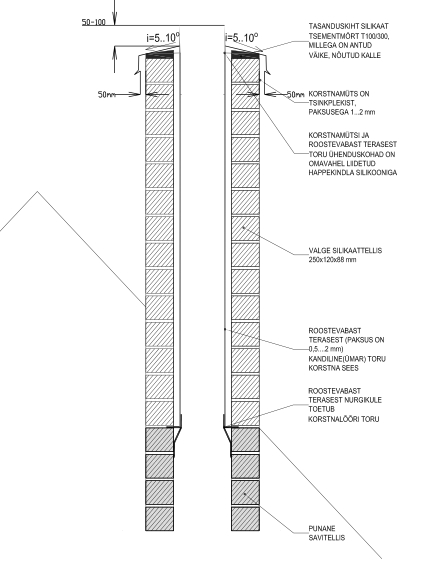
Good to know:
Section 41 of the Building Act – operation of contractors in the field of building work
(1) To be permitted to perform building work or design work, to conduct site investigations or energy audits or owner supervision or expert assessments of building design documentation or expert assessment of construction works, to issue energy performance certificates and to engage in project management a person must be an undertaking as defined in the Commercial Code and the person must:
1) registered in the register of economic activities (hereinafter, ‘the register’), and
2) have a corresponding legal relationship with a competent person specified in section 47 of this Act (hereinafter, the ‘authorised specialist’) or, if the person is a sole proprietor, he or she must be authorised to act as an authorised specialist.
See more: https://www.riigiteataja.ee/akt/110032011005
Section 9 of the Fire Safety Act– Construction and installation of solid fuel heating devices and chimneys and connection flues
(1) Solid fuel ovens, fireplaces, kitchen ranges or other heat devices (hereinafter ovens, fireplaces or kitchen ranges) and chimneys and connection flues may be built by a potter with the professional certificate of a potter engaged in professional and economic activities.
(2) Persons not holding the professional certificate of a potter may also build or install an oven, fireplace or kitchen range and chimney and connection flue in residential buildings with one apartment, summerhouses, garden houses, farmhouses and small buildings, for own use by adhering to the requirements for construction of heating systems.
See more: https://www.riigiteataja.ee/akt/13314859
Signs implying chimney issues:
- the surface of the exterior of the chimney crumbling
· heating device lets in smoke
· there is no proper ventilation
· you can notice stone or mortar crumbles in the soot hatch
· joints are becoming empty
· there is tar inside the walls of the chimney
· tar is pressing out of the joints
· the top of the chimney is breaking
· there are cracks on the exterior of the chimney
References:
1) „Ahjud, pliidid, kaminad“ By Arvo Veski
2) „Pottseparaamat“ By Priit Aun
3) „Korstna ja küttekolde müürimine“ Publishing house Ehitame
4) „Ehitustööd“ Arvo Veski
5) EVS-EN 1443: 2006 Korstnad. Üldnõuded
6) EVS 812-3:2007 Ehitiste tuleohutus Osa 3: Küttesüsteemid
7) EVS-EN 771-2 :2011 Müürikivide spetsifikatsioon. Osa 2: Silikaatmüürikivid
Drawing of a silicate brick chimney head
